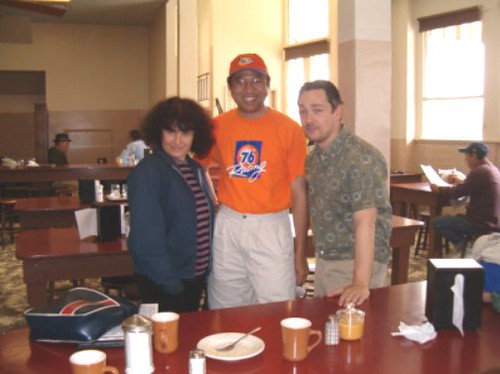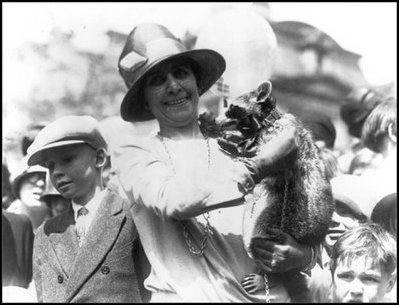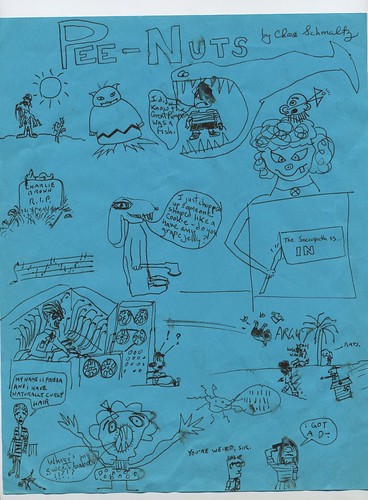Category: Kim Cooper
Cough Syrup Fiend
June 22, 1927
Los Angeles
Ranch dweller Grace Haynes was in divorce court today, seeking her freedom from husband Amos on grounds of extreme cruelty.
He didn’t abuse her, per se, but she claimed to be terrorized by his habit of knocking back bottles of high-octane cough syrup, after which he’d commence to ranting and raving before wandering out to the pig pen and beating holy hell out of their swine herd. And that can’t be good for the pork chops.
Amos denied the accusation, countering that he’d be happy to take Grace back if she’d just stop running around all night. A fascinated Judge Bowron continued the case to hear more the next morning, but the papers failed to report if Amos was delusional or Grace an imaginative liar, and whether or not the pigs turned up seeking damages.
Sooooo-ey!
Not So Meek
June 21, 1927
Pasadena
"Meek little wives feel the edge of the carving knife and study their husbands’ necks. Anything can happen." -Raymond Chandler
Subject to what was described as "a subtle malady," Mrs. Katherine Dwyer, 50, stocky, determined, crept up behind husband George, Pacific Electric Railway gateman, as he stood at the kitchen sink eating his lunch at 184 Carlton Street, and neatly drew a razor ’round his throat.
Dwyer’s gurgling drew the attention of housekeeper Miss Slade, who called George Spiegel of #146 for aid. Together they wrestled the blade away from Mrs. Dwyer, Miss Slade gaining a slash to the scalp for her trouble. Policeman A.O. Boyd arrived as the second victim was attacked, and promptly signed an insanity complaint, sending the lady the psychopathic ward of General Hospital.
George Dwyer may die. The couple had quarreled about their daughter, and Mrs. Dwyer, while never previously violent, had been treated for mental problems in the past.
1947project Podcast #2, June 16 2007
and Crimebo discussing the past two weeks of 1927 mayhem, Crimebo’s advice for young felons, event calendar for 1927 and today and more of Nathan’s kah-razy 1920s radio ads. Enjoy!
Kiss of Death
Los Angeles
When the peddler peeked into the back window of John and Lydia Kiss’ home at the defunct address of 1843 Woolan Avenue he found, not a likely prospect, but a pair of gently swaying corpses, result of the couple’s successful suicide pact. Beneath their feet were upturned boxes, suggesting they had stood together and kicked off into eternity.
Lydia, 53, had terminal cancer, and she and John chose to go out together rather than await her inevitable death. Lydia left several notes in Hungarian saying that she and John were tired of life, and their relatives, including a son in L.A., a daughter in Long Beach, and two sons in Chicago, would likely be happy to have their money. $1500 in cash was found in the home.
In memory of Earl Ma, 1971-2007
It is with great sadness that I announce that Earl Ma has died after a long battle with cancer. In addition to being a lovely guy with vast stores of energy and passion, Earl was instrumental in the campaign to save his beloved 76 Balls.
It began with his interviewing Nathan Marsak and myself for a feature in Check the Oil! magazine, but he soon became the go-to guy whenever another journalist covering the campaign needed to put Union 76 into its proper historical context. Earl knew everything about the brand, and was always generous responding to anyone’s questions. And in his spare time, he made an effort to videotape every 76 Ball, ideally spinning, that he could find and shared those tapes on Youtube so future generations could see lost balls in situ.
I only met Earl once, for a breakfast and Philippe’s in downtown LA with fellow 76 Ball geeks J. Eric Freedner and Nathan, but recognized him immediately in his Union 76 regalia. We all had a great visit, with no idea it would be our last.

I greatly appreciated Earl’s intelligence, kindness and reliability. He was a true gentleman, and it’s some small consolation to know that he left this plane knowing that the 76 Ball lives on in large part thanks to his efforts.
Godspeed, Earl, and thanks for all your good work and friendship.
June 23: Esotouric Weird West Adams vintage dress-up tour
https://www.esotouric.com/adams-6-23-07
The tour will end around 3pm, and be followed by a reception with refreshments at the Susan Wilshire Residence, a private historic home nearby. The reception precedes WAHA’s Preservation Meeting on the topic of "Local History: Visual Storytelling," demonstrating the new Powerpoint narratives the city requires along with landmark applications. See old photos and ephemera related to Felix Chevrolet, the first (1878) farmhouse in Jefferson Park, a 1902 Tudor mansion on what was then Bankers’ Row by USC, and a fab Craftsman/Art Nouveau mansion in Victoria Park built by Michael Shannon, LA’s first traffic cop.
On this tour through the Beverly Hills of the early 20th Century, passengers thrill to the carjacking horror of silent film starlet Myrtle Gonzalez, shiver as Dream Killer Otto Parzyjegla chops his newspaper publisher boss to pieces with the paper-cutting blade, shudder at the pickled poignancy of the murder-by-brandy of Benjamin Weber, then gag at terrible fate visited on kidnap victim Marion Parker by The Fox. There will be some celebrity sites along the route, including the death scenes of Motown soul sensation Marvin Gaye and 1920s star Angels baseball catcher Gus Sandberg. And the architecture too is to die for.
Hope to see you there!
Kim
Lady drivers and presidential pets
Alhambra
Car dealer R.C. Kane thought he was about to close a sale, and perhaps was leaning back with an air of satisfaction when the would-be buyer, Mrs. R.N. Upton, became startled at an intersection as another car approached.
She went for the brake, but hit the gas, and the car careened into Judge F.W. Houser’s yard and smacked into a concrete post. Kane and Upton, in the front seats, both went through the windshield and were severely cut and lacerated. In the back, Kane’s wife went out the window, and like Dwight Lesley was cut and bruised. The car was wrecked: NO SALE!
The victims were sent to Alhambra Hospital for treatment—all save Mrs. Upton, who insisted on seeing a Christian Science practitioner. 
Meanwhile, in Washington, D.C., President and Mrs. Coolidge’s pet raccoon Rebecca, a beloved pardon case from the White House larder one Thanksgiving, escaped and led staff on a two hour spree around the trees of the temporary White House, before climbing down and nonchalantly returning to her stump behind the residence. For more about the Coolidge’s interesting pets, see this article, with much on Rebecca towards the end.
Dirty Books and Lost Films
Hollywood
Book dealer P. Gordon Lewis, 39, has been arrested on a charge of attempting to provide obscene works through the mail, following a correspondence with a rat fink in Lakeland, FLA named Mrs. Collins B. Whiting. Whiting initiated the exchange when she wrote to inquire if Lewis could provide certain "erotic works," to which he replied that he had "several excellent examples of amatory works." This was sufficient to bring down the hammer of the United States District Attorney, which charged Lewis with using the US mails to sell obscene literature. He was arrested at his home at 2033 ¼ Vista Del Mar Street and held on $5000 bail.
Two years ago, Lewis was arrested on a similar charge at his shop at 1817 Ivar for mailing a copy of his sister Gladys Adelina Selma Lewis’ (pen name Georges Lewys) privately printed The Temple of Pallas-Athenae (1924). The book, financed by subscribers and printed in a run of 995, is the story of an ugly Greek princess who establishes a human stud service by which to test her theories of eugenics.
While President Coolidge was a fan and she was decorated by the French government for her war poem on Verdun, Georges Lewys is perhaps more notable for her legal battles than for her literary achievements. In 1927 she was subject to an injunction from her one-time friend Erich Von Stroheim over a privately printed fictional volume closely based on his scenario for the film Merry-Go-Round, from which he was removed as director by producer Irving Thalberg (supposedly after he learned that Stroheim wanted his extras to wear silk underwear embroidered with the Austro-Hungarian crown). She responded to his $50,000 suit with one for $100,000, and also sued Universal for the entirety of the film’s $3,000,000 profits. Lewys’ book, dedicated to Stroheim and blithely noted to be "from the Austrian" is considered by Stroheim scholars to be the key to understanding the director’s intentions for his film of pre-War Viennese life and love, with its scenes of voyeurism and sadomasochism. The New York Times reported that Miss Lewis received an out of court settlement–perhaps to hush discussion of the book and its racy subject matter.
In 1929, then 30 and living with her mother in the Belnord Apartments at Broadway and 86th Street, New York, Miss Lewis unsuccessfully sued Eugene O’Neill in Federal Court for $1,250,000, charging plagiarism of her characters in The Temple of Pallas-Athenae for his play Strange Interlude. She said she wrote the story in 1917, and that it had sold for $20. O’Neill claimed never to have heard of the "crazy" authoress, who erupted with some unintentionally hilarious remarks about her artistic character while on the stand, and Judge Woosley declared that while there might be some similarities between the characters, character types could not be owned by any author.
“It is true that there are old and young people in both plots. It is true that there are fathers and mothers and daughters and sons. But, after having carefully read both books more than once, I think it is fair to say that in the plaintiff’s book the characters are merely types — the socially ambitious mother and daughter, the obtuse but successful American business man, the dissipated foreign nobleman, the middle aged English philanderer, and the fabulously rich Russian princess. None of these types is individualized sufficiently to make the characters of the defendant any possible infringement of the plaintiff’s copyright.”
In 1931 Miss Lewis was ordered to pay O’Neill and his associates $17,500 in damages that she did not have, and there the matter rested. Later, she wrote a biography of the coloratura soprano Adelina Patti, her godmother and her mother’s dear friend.
The Lewises are native Angelenoes whose late father Meyer was a leading shoe retailer in the 1880s at 101 and 103 North Spring Street, with a fabulous home on Grand Avenue (A.M. Adelman, 1890). Their mother is author Selma Lewis.
Ask the Dust… there’s certainly enough of it

Richard returned with photog Meeno Peluce and documented the miasma, then began calling city agencies in hopes, not of delaying the inevitable demolition, but of at least getting a plaque or street sign to honor the author and the work. Sadly, it seems the city only provides plaques for buildings that have been designated historic, and the only designation this poor, abandoned place is likely to get now is "Pee-YOU!" But we’ll keep trying; Fante deserves as much.
Stephen Cooper, author of Full of Life: A Biography of John Fante says, "When Ask the Dust was published in 1939, the young novelist John Fante was living with his wife Joyce at 826 South Berendo. Today the story of Arturo Bandini and Camilla Lopez is widely considered the starting point of Los Angeles literature. If the abandoned apartment building where Fante realized his masterpiece is torn down and hauled away, the neighborhood will be removing an eyesore but the city will be losing a piece of its history. I join with all who urge that this site be recognized in some concrete and permanent way so as to preserve the memory of the incandescent time when John Fante called South Berendo home."
Meanwhile, just a few miles north, a short portion of Berendo has been renamed for another notable L.A. author, L. Ron Hubbard. It would be sweet if the same could one day be said of the 800 South block and Fante.




